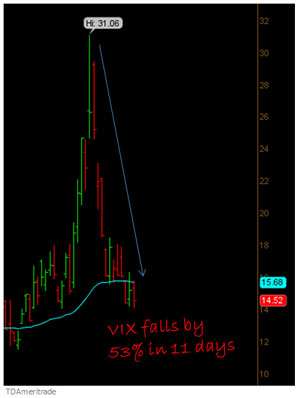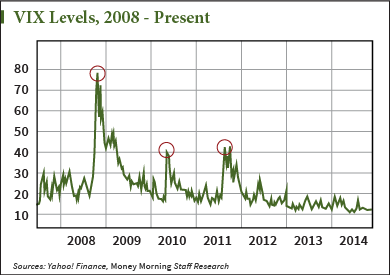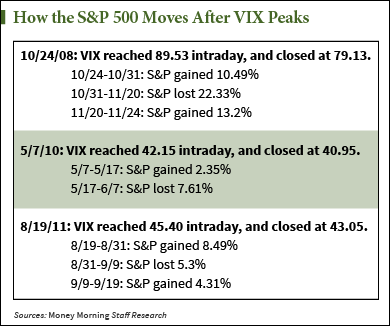 The VIX (Volatility Index) has dominated financial news over the past month.
The VIX (Volatility Index) has dominated financial news over the past month.
It made headlines when it closed at a two-year high of 26.3 on Oct. 15. In that same trading session, it went from a low of 16.09 to an intraday peak of 31.06 - the highest level since 2011.
Then the VIX grabbed attention for tumbling back down. As of yesterday (Tuesday), the VIX has backed off 53% from its October record.
But exactly what is the VIX, and why is it important for investors to understand?
Here's a VIX breakdown for Money Morning readers...
What Is the VIX?
VIX is the ticker symbol for the Chicago Board Options Exchange (CBOE) Volatility Index. The CBOE's index is a way to measure traders' expectations of stock market volatility over the next 30 days.
To do this it tracks S&P 500 options activity. The index's readings are calculated using a formula that accounts for near- and next-term put and call options on the S&P.
Money Morning Chief Investment Strategist Keith Fitz-Gerald, a 33-year seasoned market analyst and professional trader, recently told his Total Wealth research service subscribers how to interpret VIX readings: "A VIX reading of 15 means that traders believe the S&P 500 will move by less than 15%/√12, or 4.33%, over the next 30 days," Fitz-Gerald said. "The VIX is always expressed in percentage points based on a single standard deviation move, which is 68%, give or take, if you remember your high school statistics classes."
Last month when the VIX hit 26.3, that meant traders believed the S&P 500 would move by about 7.6% (26.3%/√12 = 7.6%) over the next 30 days. The high reading shows that traders anticipated market volatility ahead. The reason? Ebola virus fears were causing big moves - down and then up - in the S&P.
That's why the VIX is popularly called "the fear gauge" or "the fear index." Bigger bets on volatility are usually tied to panic in the markets.
History underscores the moniker. Some of the VIX's highest levels were reached in times of stock market crises. It shot up when the dot-com bubble burst in 2001, when derivatives imploded in 2008, and during the European debt crisis in 2010.
 But Fitz-Gerald warned readers that the VIX more accurately measures uncertainty rather than fear - a crucial difference for investors...
But Fitz-Gerald warned readers that the VIX more accurately measures uncertainty rather than fear - a crucial difference for investors...
"The VIX rises because there's uncertainty, not necessarily because there is fear," Fitz-Gerald explained. "That's a common misperception promulgated by the media because it makes for sensational headlines."
You see, a high VIX reading doesn't guarantee stocks are going to go down. In fact, high VIX readings tell you that stocks could just as easily go up.
 "I know high VIX readings can be scary, but take a deep breath," Fitz-Gerald said. "As an investor, this second side to the volatility coin means that there is ample incentive for to stay in the game even if things get crazy. Volatility is not a bad thing."
"I know high VIX readings can be scary, but take a deep breath," Fitz-Gerald said. "As an investor, this second side to the volatility coin means that there is ample incentive for to stay in the game even if things get crazy. Volatility is not a bad thing."
The Bottom Line: As an investor, you actually want to see plenty of movement in the VIX.
"Investors are always trying to profit from changes in price," Fitz-Gerald said. "If you ever hang around professional traders, that's something you'll hear a lot. What they hate is markets that go nowhere because that limits their opportunity - and yours."
In the Oct. 31 issue of Total Wealth - a guide for investors to spot trends, pick trades, and build wealth - Keith took the VIX conversation one step further. He told readers exactly how to trade volatility, enabling them to profit whether the VIX is low or high. Sign up for his e-letter for all the details - it's free!


